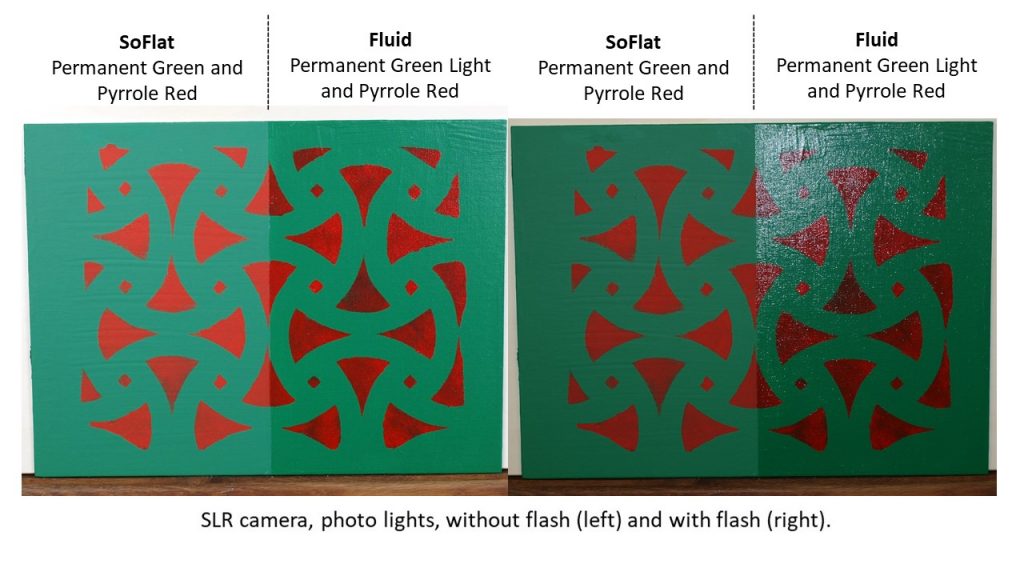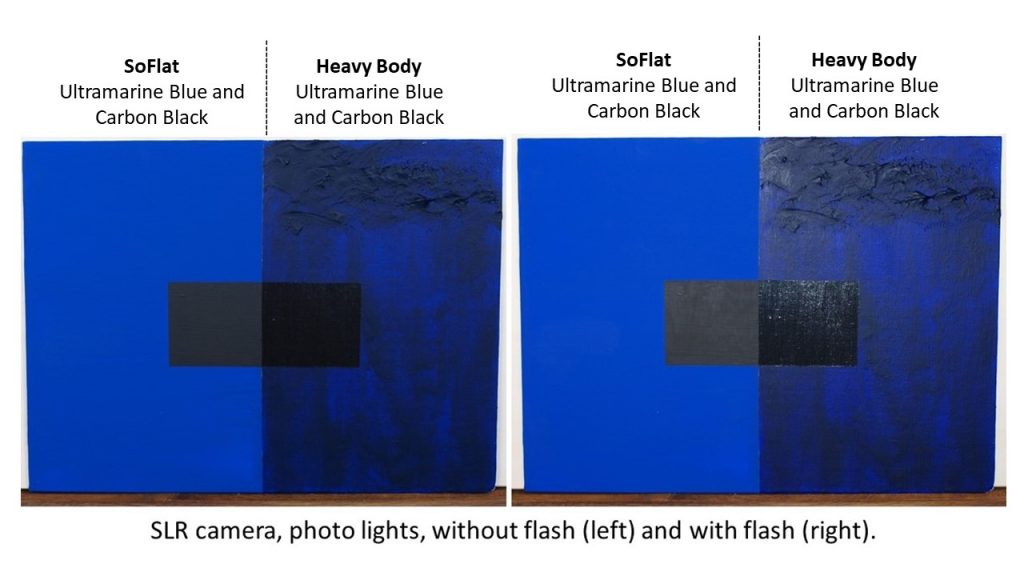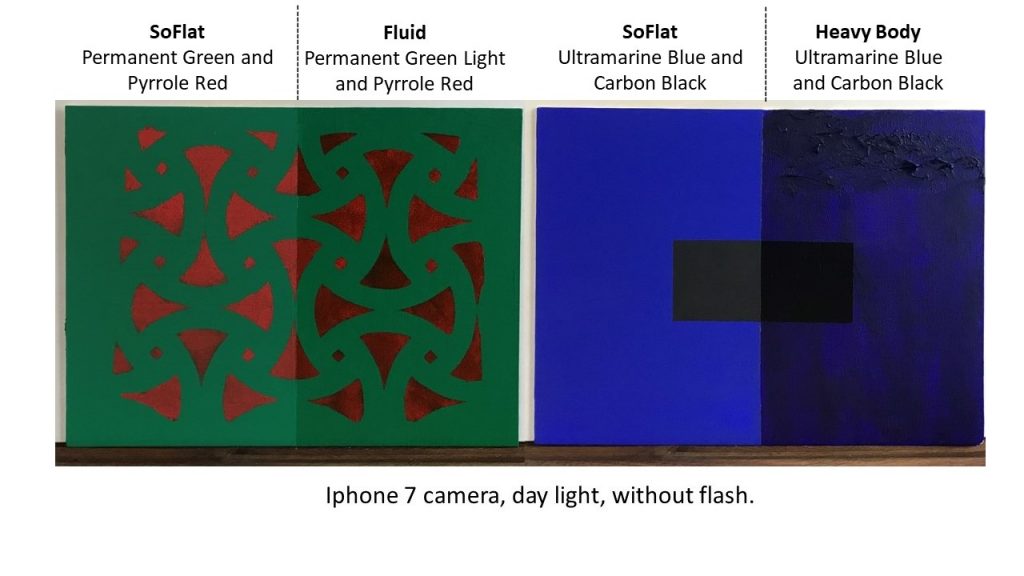Glare and reflections are the typical challenge when photographing paintings with a glossy finish. We can do our best by photographing in indirect sunlight, which provides the best lighting, and eliminate shadows and “hot spots” as best we can, and still find that the light distorted the representation of our original artwork. Getting reliable and good shots of artwork with a matte finish is much easier compared to a glossy one. SoFlat has such a uniform matte sheen across the product line, that it translates exceptionally well from the physical painting to the digital image.
Gloss Measurements – how matte exactly are the SoFlat Matte colors?
The human eye is much better at noticing differences in the low-gloss ranges than the high gloss ones. Therefore, controlling the gloss of our SoFlat paints is important, since artists could quickly notice if one color has a different sheen than the rest. We use a professional and standardized method for measuring the surface gloss of our paints, with a so-called gloss meter, also known as a reflectometer or glossometer. The gloss meter shines a known amount of light at a flat surface and quantifies the amount of light that is reflected back. A surface which reflects all the light at the same angle (so-called specular reflection) will have a high meter value and thus, a glossy surface. If light is reflected in all possible directions, we speak of diffuse reflection and that makes for lower values and a matte surface.


There are three internationally standardized angles at which the light can be pointed at the surface that is to be measured for gloss: 20°, 60° and 85°. Depending on the glossiness of a surface, one of these three geometries is best suited for getting the most accurate testing results. The 85 degree gloss meter is more sensitive to differences on low-gloss surfaces and the 60 degree gloss meter works best for everything in the middle.
The gloss units (GU) for most non-metallic materials fall within a range between 100 for high gloss to 0 for perfectly matte surfaces. A trained observer can just notice a gloss difference of 5 GU, presuming it was measured with the correct geometry. SoFlat gloss readings fall between 0.4 and 3 – compared to a range of 13-100 for our Fluid Acrylics and 8-99 for our Heavy Body Acrylics, all measured at 60° geometry. Therefore, the SoFlat paint line should appear perfectly equal in matteness across the color lines to us, whereas gloss differences in the Fluid and Heavy Body lines are easily discernable.
Table of gloss readings for all SoFlat Matte colors

Photographing SoFlat Matte
In order to demonstrate how photogenic SoFlat Matte Colors are, we prepared sample boards of both SoFlat Matte (left) and Heavy Body and Fluid Acrylics (right). We photographed the panels once in daylight on an overcast day and once with two photo lights with and without camera flash lights. For our photographs we used a SLR- camera and the camera of an Iphone 7. None of the images were edited.



The difference between the glossy acrylics and the SoFlat Matte became most apparent when using a flash light. What is also striking is how much lighter the SoFlat Matte Colors are in value. When light hits the SoFlat Matte surface, the reflected light is scattered into all directions by the exposed pigment and matting solid particles, which causes the surface to appear lighter.
Conclusion
Because SoFlat paints are so much more matte than nearly anything in Heavy Body, Fluid, OPEN or High Flow colors, there are some new possibilities and distinct advantages. Paintings using SoFlat with other lines of our paints can play with the contrasts that matte and gloss surfaces provide in a single work, making possible a wider range of expression. On the other hand, paintings done solely with SoFlat will be easier to photograph in a consistent and even manner, making them ultimately easier to incorporate into digital media; a direction no one will deny the arts, and everything else, are headed towards. So, just snap the shot and you are ready to go!
About Mirjam Auf der Mauer
View all posts by Mirjam Auf der Mauer -->Subscribe
Subscribe to the newsletter today!
No related Post

No doubt I’m only half understanding this post. Does this mean that when photographing glossy paintings, the photo lights should not necessarily be set at a 45 degree angle to the artwork? (Forty-five degrees being the usual advice.) Thanks!
Hello Cynthia,
when photographing glossy artwork, it is helpful to experiment with the direction and angle of lights. 45 degree angle is a good place to start, but might create some reflections or glare. It sometimes also helps to paint the lights away from the painting towards the ceiling, so that only indirectl light hits the paintings surface.
as a qualified master photographer your on the right track with matt surfaces to get the best results use natural diffused light for the best results like I used to prefer for photograpying weddings natural pastel even light always produces excellent results kind regards Steve
Thank you for sharing your professional experience, Stephen.
I have not had a chance to use them yet! Just got yesterday!
What is the best medium so use to get a totally matte finish if you are using Fluid or Heavy Body acrylics?
You can use the GOLDEN Super Matte Medium to mix with your Fluid or Heavy Body paints in order to decrese the sheen, but it will not provide the same mattness as the SoFlat Matte colors. Alternatively, you can finish your painting in Fluid and/or Heavy Body paints, apply an Isolation Coat and finish with a layer or two of Matte MSA or Archival Varnish. Check out our varnishing resourcs for instructional videos & product use instructions: https://www.goldenpaints.com/technicalinfo/technicalinfo_varnishresources
I’ve successfully photographed art while it remained in its frame, in which the frame held standard glass (without any non-glare coatings). To do this, I used strobes in soft boxes set at 45 degree angles on either side of each framed image. Because the light was even and bounced off the glass at the same 45 degree angles with which came from its sources, no reflections were evident from the glass or from the art.
To understand this, you might think of how a ball will bounce off the side of a pool or billiard table, and how the angle of the ball’s approach will be theoretically equal to the angle with which it is deflected as it leaves the pool table’s side. Light will bounce off of glass in the same way. However, a slight imperfection in the glass can cause a small spot of light to bounce towards the camera, so the framing glass needs to be of high quality, if it is to be left in place.
The texture of a painting’s brushstrokes can also deflect light towards the camera, just as imperfections in glass can do that. This can be even more pronounced when the paint has a glossy surface. To counter this when photographing textured, glossy paintings, you’ll need to place a large polarizing filter over each light source and use another polarizing filter over the lens. And even then, you may need to perform some work in photoshop to obtain good quality representations of each painting.